Project Risk and Procurement Management: A Risk Mitigation Strategy
VerifiedAdded on 2022/09/28
|15
|4327
|25
Project
AI Summary
This project delves into project risk and procurement management, employing a wedding event as a practical case study. The paper initiates with an introduction to risk management, emphasizing its significance in project success and highlighting the challenges involved. The first part focuses on identifying potential risks associated with a wedding, encompassing various aspects from vendor reliability to unforeseen circumstances like weather disruptions or security breaches. A comprehensive risk matrix is developed to assess the likelihood and severity of these risks. Building upon this foundation, the second part narrows down the identified risks to a top ten list and outlines a detailed risk management plan. This plan incorporates four key risk management strategies: risk avoidance, risk acceptance, risk transfer, and risk mitigation. For each of the top ten risks, the paper proposes specific risk controls, providing a practical framework for managing and minimizing potential negative impacts. The project emphasizes the need for proactive risk management to ensure a successful wedding event and underscores the importance of adapting strategies based on the specific circumstances and potential impacts of each identified risk.
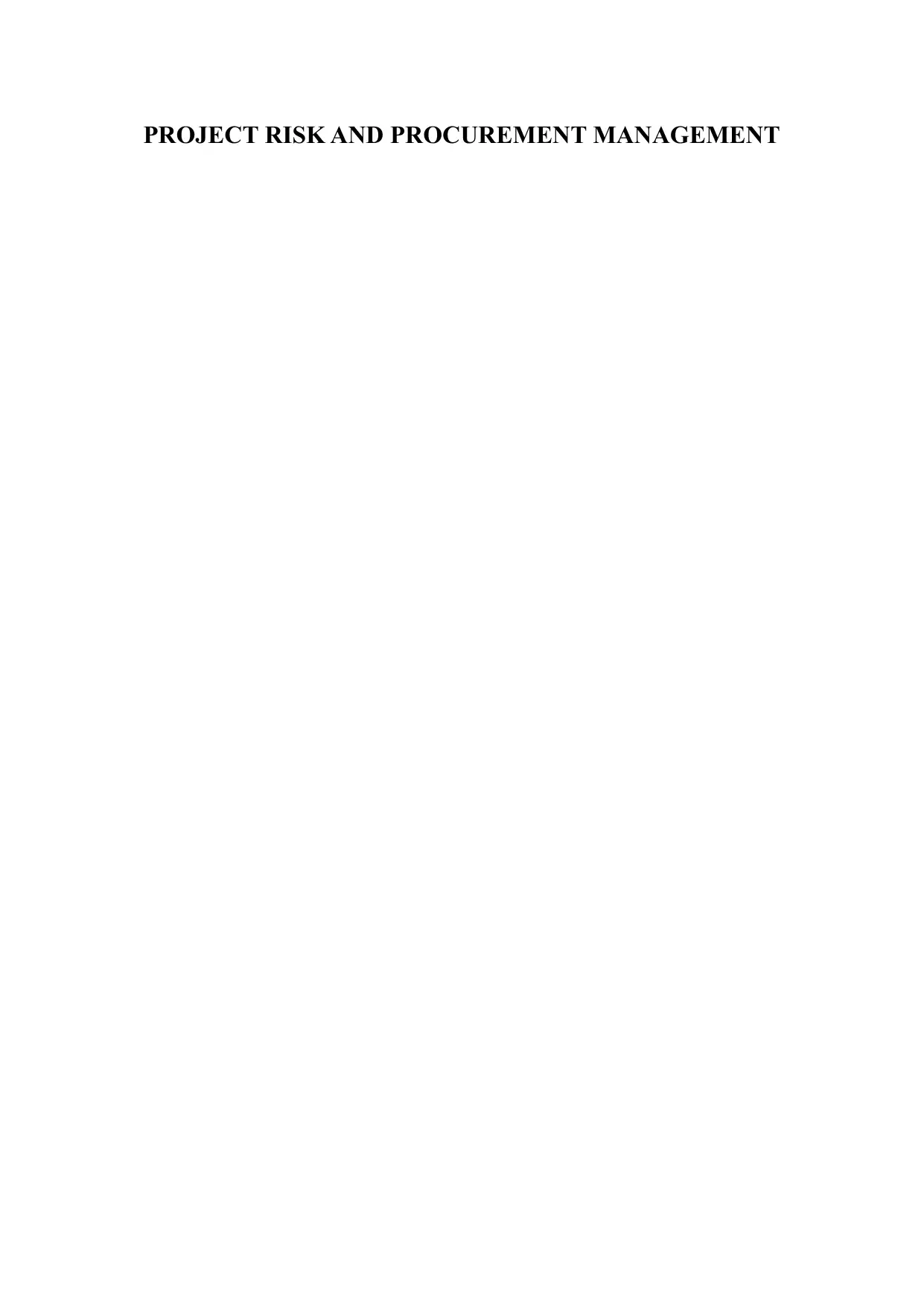
PROJECT RISK AND PROCUREMENT MANAGEMENT
Paraphrase This Document
Need a fresh take? Get an instant paraphrase of this document with our AI Paraphraser

Table of Contents
Introduction...................................................................................................................................................................3
Part One.........................................................................................................................................................................4
Risks for a wedding.................................................................................................................................................4
Part Two: Risk management form the identified Risks................................................................................................6
Risk management Strategies...................................................................................................................................6
Conclusion..................................................................................................................................................................10
References...................................................................................................................................................................11
Introduction...................................................................................................................................................................3
Part One.........................................................................................................................................................................4
Risks for a wedding.................................................................................................................................................4
Part Two: Risk management form the identified Risks................................................................................................6
Risk management Strategies...................................................................................................................................6
Conclusion..................................................................................................................................................................10
References...................................................................................................................................................................11
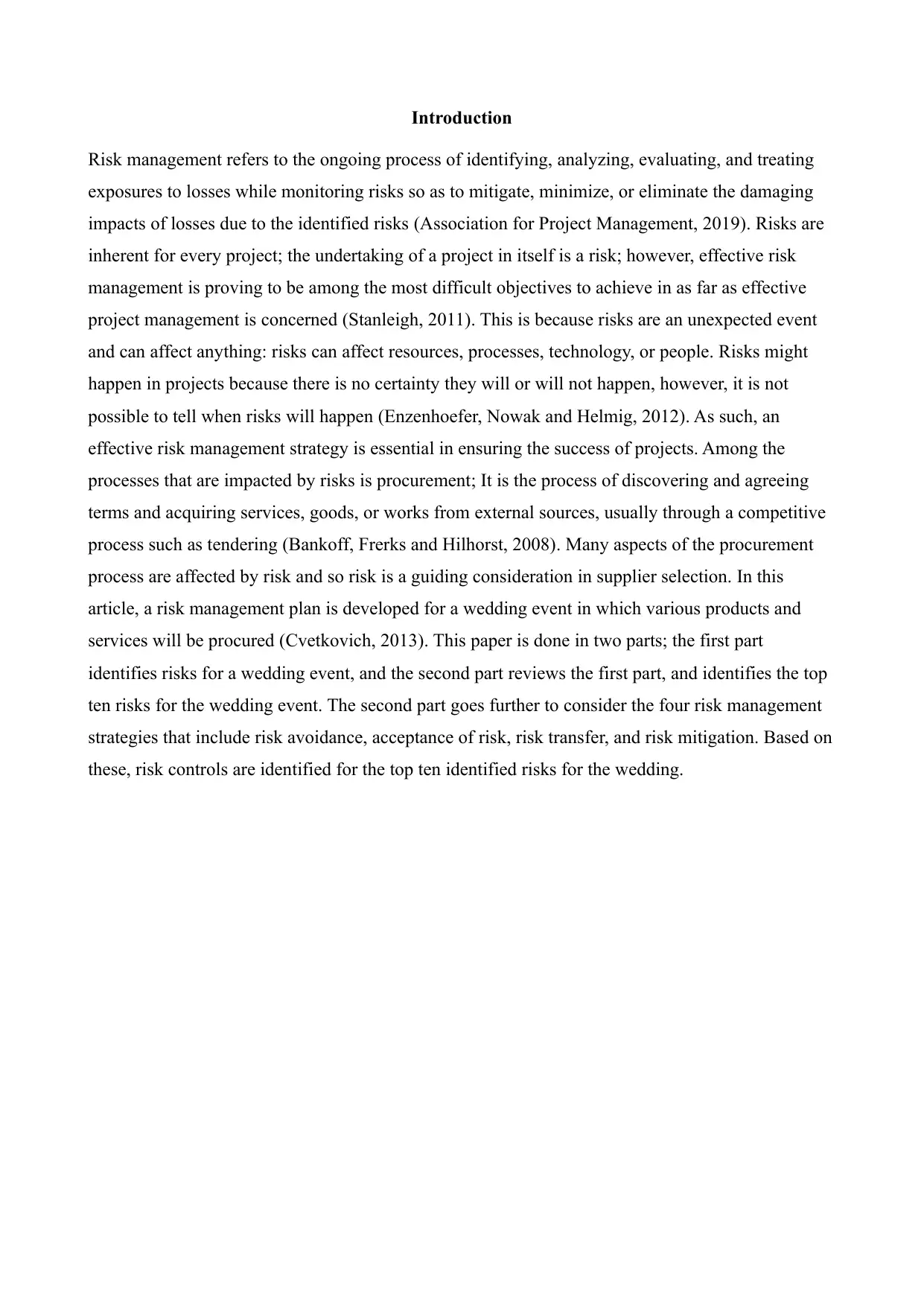
Introduction
Risk management refers to the ongoing process of identifying, analyzing, evaluating, and treating
exposures to losses while monitoring risks so as to mitigate, minimize, or eliminate the damaging
impacts of losses due to the identified risks (Association for Project Management, 2019). Risks are
inherent for every project; the undertaking of a project in itself is a risk; however, effective risk
management is proving to be among the most difficult objectives to achieve in as far as effective
project management is concerned (Stanleigh, 2011). This is because risks are an unexpected event
and can affect anything: risks can affect resources, processes, technology, or people. Risks might
happen in projects because there is no certainty they will or will not happen, however, it is not
possible to tell when risks will happen (Enzenhoefer, Nowak and Helmig, 2012). As such, an
effective risk management strategy is essential in ensuring the success of projects. Among the
processes that are impacted by risks is procurement; It is the process of discovering and agreeing
terms and acquiring services, goods, or works from external sources, usually through a competitive
process such as tendering (Bankoff, Frerks and Hilhorst, 2008). Many aspects of the procurement
process are affected by risk and so risk is a guiding consideration in supplier selection. In this
article, a risk management plan is developed for a wedding event in which various products and
services will be procured (Cvetkovich, 2013). This paper is done in two parts; the first part
identifies risks for a wedding event, and the second part reviews the first part, and identifies the top
ten risks for the wedding event. The second part goes further to consider the four risk management
strategies that include risk avoidance, acceptance of risk, risk transfer, and risk mitigation. Based on
these, risk controls are identified for the top ten identified risks for the wedding.
Risk management refers to the ongoing process of identifying, analyzing, evaluating, and treating
exposures to losses while monitoring risks so as to mitigate, minimize, or eliminate the damaging
impacts of losses due to the identified risks (Association for Project Management, 2019). Risks are
inherent for every project; the undertaking of a project in itself is a risk; however, effective risk
management is proving to be among the most difficult objectives to achieve in as far as effective
project management is concerned (Stanleigh, 2011). This is because risks are an unexpected event
and can affect anything: risks can affect resources, processes, technology, or people. Risks might
happen in projects because there is no certainty they will or will not happen, however, it is not
possible to tell when risks will happen (Enzenhoefer, Nowak and Helmig, 2012). As such, an
effective risk management strategy is essential in ensuring the success of projects. Among the
processes that are impacted by risks is procurement; It is the process of discovering and agreeing
terms and acquiring services, goods, or works from external sources, usually through a competitive
process such as tendering (Bankoff, Frerks and Hilhorst, 2008). Many aspects of the procurement
process are affected by risk and so risk is a guiding consideration in supplier selection. In this
article, a risk management plan is developed for a wedding event in which various products and
services will be procured (Cvetkovich, 2013). This paper is done in two parts; the first part
identifies risks for a wedding event, and the second part reviews the first part, and identifies the top
ten risks for the wedding event. The second part goes further to consider the four risk management
strategies that include risk avoidance, acceptance of risk, risk transfer, and risk mitigation. Based on
these, risk controls are identified for the top ten identified risks for the wedding.
⊘ This is a preview!⊘
Do you want full access?
Subscribe today to unlock all pages.

Trusted by 1+ million students worldwide
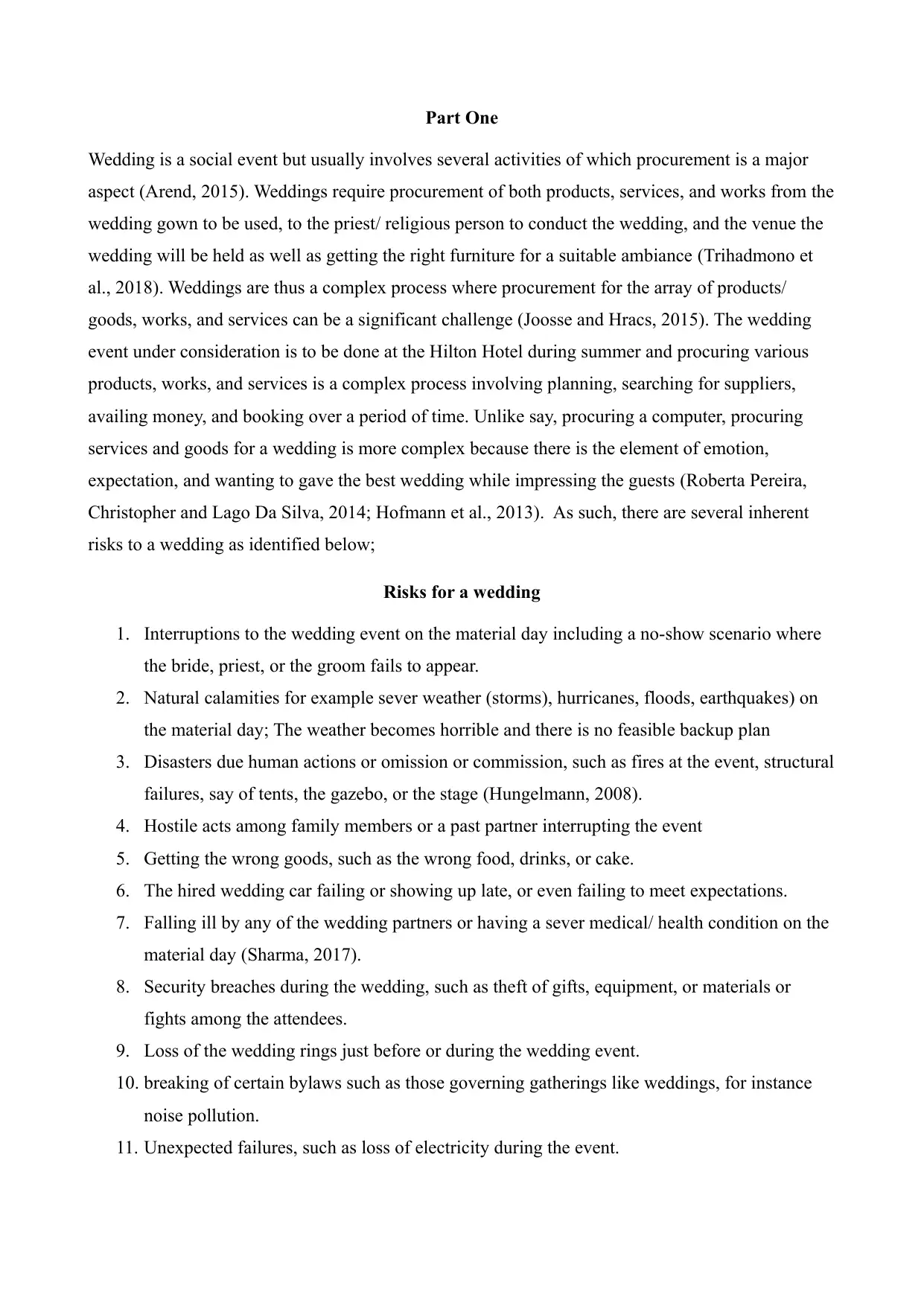
Part One
Wedding is a social event but usually involves several activities of which procurement is a major
aspect (Arend, 2015). Weddings require procurement of both products, services, and works from the
wedding gown to be used, to the priest/ religious person to conduct the wedding, and the venue the
wedding will be held as well as getting the right furniture for a suitable ambiance (Trihadmono et
al., 2018). Weddings are thus a complex process where procurement for the array of products/
goods, works, and services can be a significant challenge (Joosse and Hracs, 2015). The wedding
event under consideration is to be done at the Hilton Hotel during summer and procuring various
products, works, and services is a complex process involving planning, searching for suppliers,
availing money, and booking over a period of time. Unlike say, procuring a computer, procuring
services and goods for a wedding is more complex because there is the element of emotion,
expectation, and wanting to gave the best wedding while impressing the guests (Roberta Pereira,
Christopher and Lago Da Silva, 2014; Hofmann et al., 2013). As such, there are several inherent
risks to a wedding as identified below;
Risks for a wedding
1. Interruptions to the wedding event on the material day including a no-show scenario where
the bride, priest, or the groom fails to appear.
2. Natural calamities for example sever weather (storms), hurricanes, floods, earthquakes) on
the material day; The weather becomes horrible and there is no feasible backup plan
3. Disasters due human actions or omission or commission, such as fires at the event, structural
failures, say of tents, the gazebo, or the stage (Hungelmann, 2008).
4. Hostile acts among family members or a past partner interrupting the event
5. Getting the wrong goods, such as the wrong food, drinks, or cake.
6. The hired wedding car failing or showing up late, or even failing to meet expectations.
7. Falling ill by any of the wedding partners or having a sever medical/ health condition on the
material day (Sharma, 2017).
8. Security breaches during the wedding, such as theft of gifts, equipment, or materials or
fights among the attendees.
9. Loss of the wedding rings just before or during the wedding event.
10. breaking of certain bylaws such as those governing gatherings like weddings, for instance
noise pollution.
11. Unexpected failures, such as loss of electricity during the event.
Wedding is a social event but usually involves several activities of which procurement is a major
aspect (Arend, 2015). Weddings require procurement of both products, services, and works from the
wedding gown to be used, to the priest/ religious person to conduct the wedding, and the venue the
wedding will be held as well as getting the right furniture for a suitable ambiance (Trihadmono et
al., 2018). Weddings are thus a complex process where procurement for the array of products/
goods, works, and services can be a significant challenge (Joosse and Hracs, 2015). The wedding
event under consideration is to be done at the Hilton Hotel during summer and procuring various
products, works, and services is a complex process involving planning, searching for suppliers,
availing money, and booking over a period of time. Unlike say, procuring a computer, procuring
services and goods for a wedding is more complex because there is the element of emotion,
expectation, and wanting to gave the best wedding while impressing the guests (Roberta Pereira,
Christopher and Lago Da Silva, 2014; Hofmann et al., 2013). As such, there are several inherent
risks to a wedding as identified below;
Risks for a wedding
1. Interruptions to the wedding event on the material day including a no-show scenario where
the bride, priest, or the groom fails to appear.
2. Natural calamities for example sever weather (storms), hurricanes, floods, earthquakes) on
the material day; The weather becomes horrible and there is no feasible backup plan
3. Disasters due human actions or omission or commission, such as fires at the event, structural
failures, say of tents, the gazebo, or the stage (Hungelmann, 2008).
4. Hostile acts among family members or a past partner interrupting the event
5. Getting the wrong goods, such as the wrong food, drinks, or cake.
6. The hired wedding car failing or showing up late, or even failing to meet expectations.
7. Falling ill by any of the wedding partners or having a sever medical/ health condition on the
material day (Sharma, 2017).
8. Security breaches during the wedding, such as theft of gifts, equipment, or materials or
fights among the attendees.
9. Loss of the wedding rings just before or during the wedding event.
10. breaking of certain bylaws such as those governing gatherings like weddings, for instance
noise pollution.
11. Unexpected failures, such as loss of electricity during the event.
Paraphrase This Document
Need a fresh take? Get an instant paraphrase of this document with our AI Paraphraser
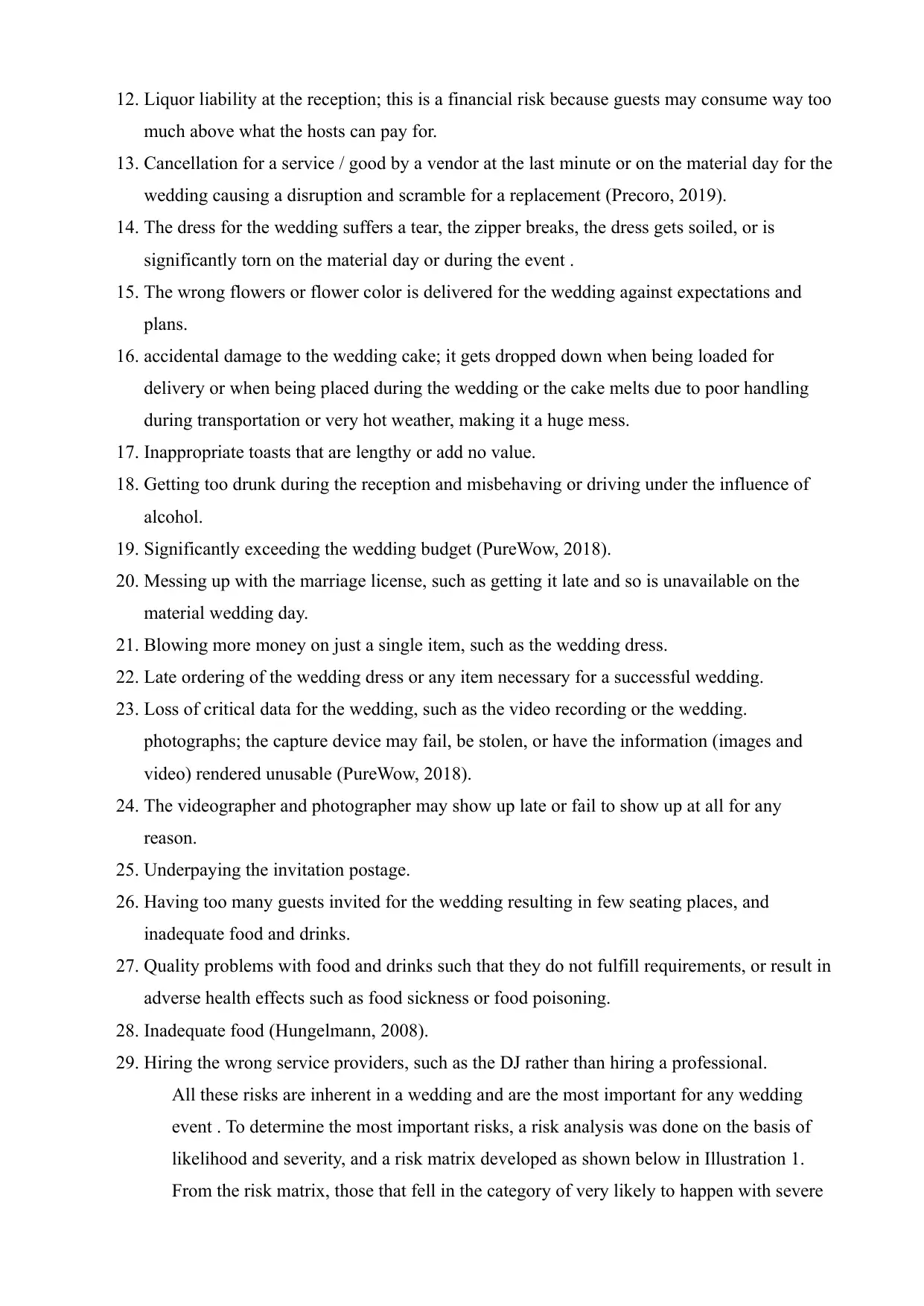
12. Liquor liability at the reception; this is a financial risk because guests may consume way too
much above what the hosts can pay for.
13. Cancellation for a service / good by a vendor at the last minute or on the material day for the
wedding causing a disruption and scramble for a replacement (Precoro, 2019).
14. The dress for the wedding suffers a tear, the zipper breaks, the dress gets soiled, or is
significantly torn on the material day or during the event .
15. The wrong flowers or flower color is delivered for the wedding against expectations and
plans.
16. accidental damage to the wedding cake; it gets dropped down when being loaded for
delivery or when being placed during the wedding or the cake melts due to poor handling
during transportation or very hot weather, making it a huge mess.
17. Inappropriate toasts that are lengthy or add no value.
18. Getting too drunk during the reception and misbehaving or driving under the influence of
alcohol.
19. Significantly exceeding the wedding budget (PureWow, 2018).
20. Messing up with the marriage license, such as getting it late and so is unavailable on the
material wedding day.
21. Blowing more money on just a single item, such as the wedding dress.
22. Late ordering of the wedding dress or any item necessary for a successful wedding.
23. Loss of critical data for the wedding, such as the video recording or the wedding.
photographs; the capture device may fail, be stolen, or have the information (images and
video) rendered unusable (PureWow, 2018).
24. The videographer and photographer may show up late or fail to show up at all for any
reason.
25. Underpaying the invitation postage.
26. Having too many guests invited for the wedding resulting in few seating places, and
inadequate food and drinks.
27. Quality problems with food and drinks such that they do not fulfill requirements, or result in
adverse health effects such as food sickness or food poisoning.
28. Inadequate food (Hungelmann, 2008).
29. Hiring the wrong service providers, such as the DJ rather than hiring a professional.
All these risks are inherent in a wedding and are the most important for any wedding
event . To determine the most important risks, a risk analysis was done on the basis of
likelihood and severity, and a risk matrix developed as shown below in Illustration 1.
From the risk matrix, those that fell in the category of very likely to happen with severe
much above what the hosts can pay for.
13. Cancellation for a service / good by a vendor at the last minute or on the material day for the
wedding causing a disruption and scramble for a replacement (Precoro, 2019).
14. The dress for the wedding suffers a tear, the zipper breaks, the dress gets soiled, or is
significantly torn on the material day or during the event .
15. The wrong flowers or flower color is delivered for the wedding against expectations and
plans.
16. accidental damage to the wedding cake; it gets dropped down when being loaded for
delivery or when being placed during the wedding or the cake melts due to poor handling
during transportation or very hot weather, making it a huge mess.
17. Inappropriate toasts that are lengthy or add no value.
18. Getting too drunk during the reception and misbehaving or driving under the influence of
alcohol.
19. Significantly exceeding the wedding budget (PureWow, 2018).
20. Messing up with the marriage license, such as getting it late and so is unavailable on the
material wedding day.
21. Blowing more money on just a single item, such as the wedding dress.
22. Late ordering of the wedding dress or any item necessary for a successful wedding.
23. Loss of critical data for the wedding, such as the video recording or the wedding.
photographs; the capture device may fail, be stolen, or have the information (images and
video) rendered unusable (PureWow, 2018).
24. The videographer and photographer may show up late or fail to show up at all for any
reason.
25. Underpaying the invitation postage.
26. Having too many guests invited for the wedding resulting in few seating places, and
inadequate food and drinks.
27. Quality problems with food and drinks such that they do not fulfill requirements, or result in
adverse health effects such as food sickness or food poisoning.
28. Inadequate food (Hungelmann, 2008).
29. Hiring the wrong service providers, such as the DJ rather than hiring a professional.
All these risks are inherent in a wedding and are the most important for any wedding
event . To determine the most important risks, a risk analysis was done on the basis of
likelihood and severity, and a risk matrix developed as shown below in Illustration 1.
From the risk matrix, those that fell in the category of very likely to happen with severe
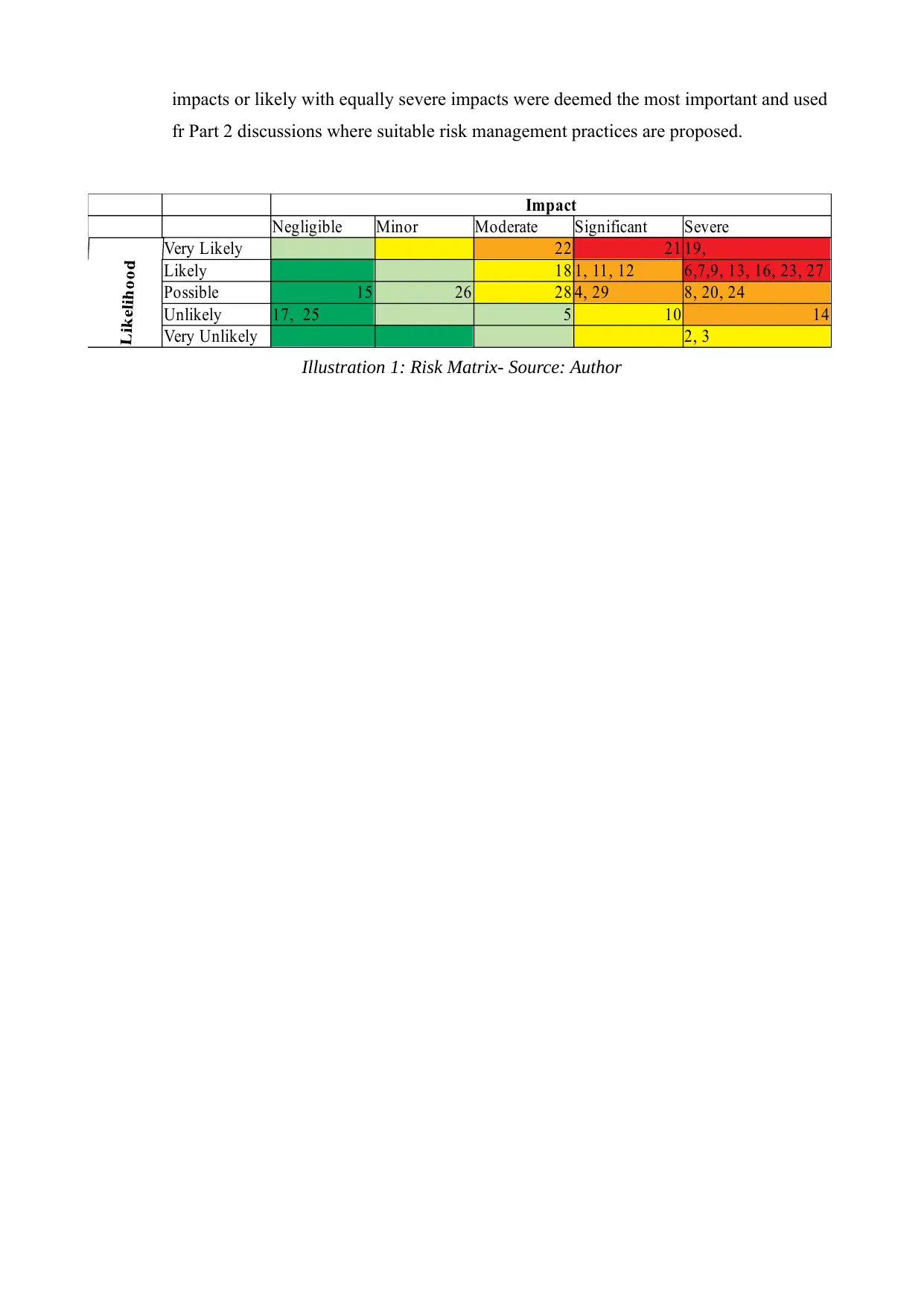
impacts or likely with equally severe impacts were deemed the most important and used
fr Part 2 discussions where suitable risk management practices are proposed.
Impact
Negligible Minor Moderate Significant Severe
Very Likely 22 21 19,
Likely 18 1, 11, 12 6,7,9, 13, 16, 23, 27
Possible 15 26 28 4, 29 8, 20, 24
Unlikely 17, 25 5 10 14
Very Unlikely 2, 3
Illustration 1: Risk Matrix- Source: Author
fr Part 2 discussions where suitable risk management practices are proposed.
Impact
Negligible Minor Moderate Significant Severe
Very Likely 22 21 19,
Likely 18 1, 11, 12 6,7,9, 13, 16, 23, 27
Possible 15 26 28 4, 29 8, 20, 24
Unlikely 17, 25 5 10 14
Very Unlikely 2, 3
Illustration 1: Risk Matrix- Source: Author
⊘ This is a preview!⊘
Do you want full access?
Subscribe today to unlock all pages.

Trusted by 1+ million students worldwide
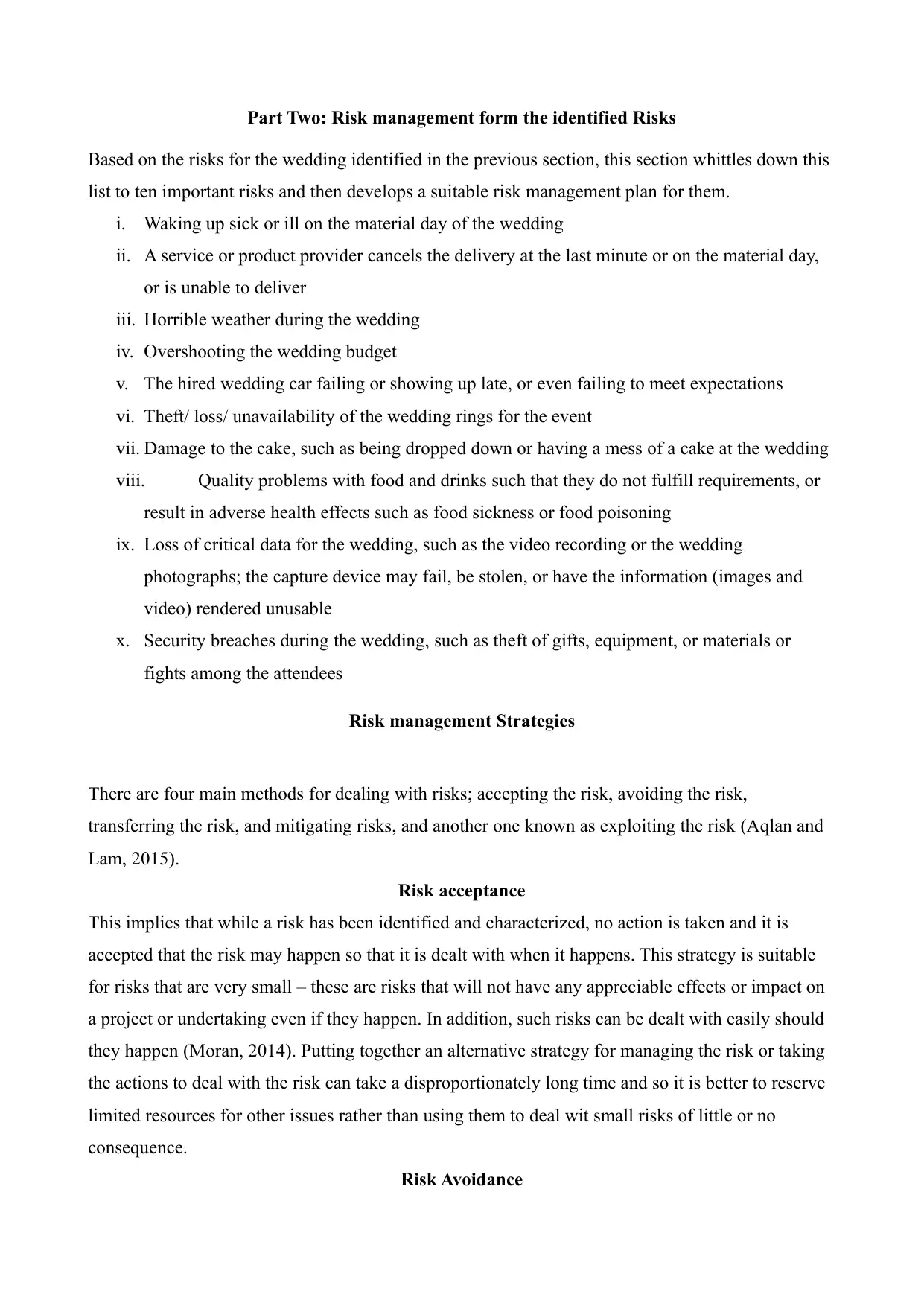
Part Two: Risk management form the identified Risks
Based on the risks for the wedding identified in the previous section, this section whittles down this
list to ten important risks and then develops a suitable risk management plan for them.
i. Waking up sick or ill on the material day of the wedding
ii. A service or product provider cancels the delivery at the last minute or on the material day,
or is unable to deliver
iii. Horrible weather during the wedding
iv. Overshooting the wedding budget
v. The hired wedding car failing or showing up late, or even failing to meet expectations
vi. Theft/ loss/ unavailability of the wedding rings for the event
vii. Damage to the cake, such as being dropped down or having a mess of a cake at the wedding
viii. Quality problems with food and drinks such that they do not fulfill requirements, or
result in adverse health effects such as food sickness or food poisoning
ix. Loss of critical data for the wedding, such as the video recording or the wedding
photographs; the capture device may fail, be stolen, or have the information (images and
video) rendered unusable
x. Security breaches during the wedding, such as theft of gifts, equipment, or materials or
fights among the attendees
Risk management Strategies
There are four main methods for dealing with risks; accepting the risk, avoiding the risk,
transferring the risk, and mitigating risks, and another one known as exploiting the risk (Aqlan and
Lam, 2015).
Risk acceptance
This implies that while a risk has been identified and characterized, no action is taken and it is
accepted that the risk may happen so that it is dealt with when it happens. This strategy is suitable
for risks that are very small – these are risks that will not have any appreciable effects or impact on
a project or undertaking even if they happen. In addition, such risks can be dealt with easily should
they happen (Moran, 2014). Putting together an alternative strategy for managing the risk or taking
the actions to deal with the risk can take a disproportionately long time and so it is better to reserve
limited resources for other issues rather than using them to deal wit small risks of little or no
consequence.
Risk Avoidance
Based on the risks for the wedding identified in the previous section, this section whittles down this
list to ten important risks and then develops a suitable risk management plan for them.
i. Waking up sick or ill on the material day of the wedding
ii. A service or product provider cancels the delivery at the last minute or on the material day,
or is unable to deliver
iii. Horrible weather during the wedding
iv. Overshooting the wedding budget
v. The hired wedding car failing or showing up late, or even failing to meet expectations
vi. Theft/ loss/ unavailability of the wedding rings for the event
vii. Damage to the cake, such as being dropped down or having a mess of a cake at the wedding
viii. Quality problems with food and drinks such that they do not fulfill requirements, or
result in adverse health effects such as food sickness or food poisoning
ix. Loss of critical data for the wedding, such as the video recording or the wedding
photographs; the capture device may fail, be stolen, or have the information (images and
video) rendered unusable
x. Security breaches during the wedding, such as theft of gifts, equipment, or materials or
fights among the attendees
Risk management Strategies
There are four main methods for dealing with risks; accepting the risk, avoiding the risk,
transferring the risk, and mitigating risks, and another one known as exploiting the risk (Aqlan and
Lam, 2015).
Risk acceptance
This implies that while a risk has been identified and characterized, no action is taken and it is
accepted that the risk may happen so that it is dealt with when it happens. This strategy is suitable
for risks that are very small – these are risks that will not have any appreciable effects or impact on
a project or undertaking even if they happen. In addition, such risks can be dealt with easily should
they happen (Moran, 2014). Putting together an alternative strategy for managing the risk or taking
the actions to deal with the risk can take a disproportionately long time and so it is better to reserve
limited resources for other issues rather than using them to deal wit small risks of little or no
consequence.
Risk Avoidance
Paraphrase This Document
Need a fresh take? Get an instant paraphrase of this document with our AI Paraphraser
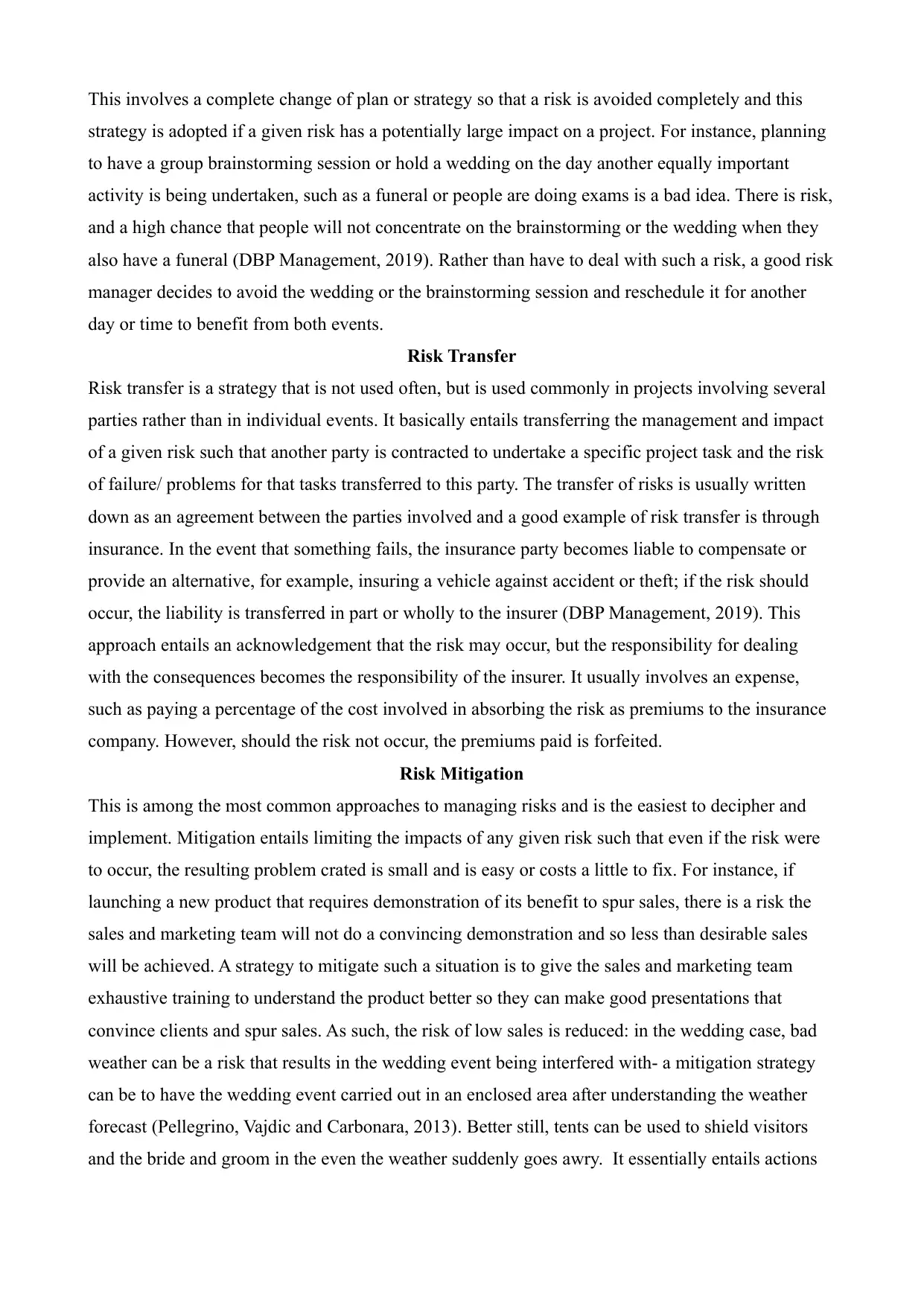
This involves a complete change of plan or strategy so that a risk is avoided completely and this
strategy is adopted if a given risk has a potentially large impact on a project. For instance, planning
to have a group brainstorming session or hold a wedding on the day another equally important
activity is being undertaken, such as a funeral or people are doing exams is a bad idea. There is risk,
and a high chance that people will not concentrate on the brainstorming or the wedding when they
also have a funeral (DBP Management, 2019). Rather than have to deal with such a risk, a good risk
manager decides to avoid the wedding or the brainstorming session and reschedule it for another
day or time to benefit from both events.
Risk Transfer
Risk transfer is a strategy that is not used often, but is used commonly in projects involving several
parties rather than in individual events. It basically entails transferring the management and impact
of a given risk such that another party is contracted to undertake a specific project task and the risk
of failure/ problems for that tasks transferred to this party. The transfer of risks is usually written
down as an agreement between the parties involved and a good example of risk transfer is through
insurance. In the event that something fails, the insurance party becomes liable to compensate or
provide an alternative, for example, insuring a vehicle against accident or theft; if the risk should
occur, the liability is transferred in part or wholly to the insurer (DBP Management, 2019). This
approach entails an acknowledgement that the risk may occur, but the responsibility for dealing
with the consequences becomes the responsibility of the insurer. It usually involves an expense,
such as paying a percentage of the cost involved in absorbing the risk as premiums to the insurance
company. However, should the risk not occur, the premiums paid is forfeited.
Risk Mitigation
This is among the most common approaches to managing risks and is the easiest to decipher and
implement. Mitigation entails limiting the impacts of any given risk such that even if the risk were
to occur, the resulting problem crated is small and is easy or costs a little to fix. For instance, if
launching a new product that requires demonstration of its benefit to spur sales, there is a risk the
sales and marketing team will not do a convincing demonstration and so less than desirable sales
will be achieved. A strategy to mitigate such a situation is to give the sales and marketing team
exhaustive training to understand the product better so they can make good presentations that
convince clients and spur sales. As such, the risk of low sales is reduced: in the wedding case, bad
weather can be a risk that results in the wedding event being interfered with- a mitigation strategy
can be to have the wedding event carried out in an enclosed area after understanding the weather
forecast (Pellegrino, Vajdic and Carbonara, 2013). Better still, tents can be used to shield visitors
and the bride and groom in the even the weather suddenly goes awry. It essentially entails actions
strategy is adopted if a given risk has a potentially large impact on a project. For instance, planning
to have a group brainstorming session or hold a wedding on the day another equally important
activity is being undertaken, such as a funeral or people are doing exams is a bad idea. There is risk,
and a high chance that people will not concentrate on the brainstorming or the wedding when they
also have a funeral (DBP Management, 2019). Rather than have to deal with such a risk, a good risk
manager decides to avoid the wedding or the brainstorming session and reschedule it for another
day or time to benefit from both events.
Risk Transfer
Risk transfer is a strategy that is not used often, but is used commonly in projects involving several
parties rather than in individual events. It basically entails transferring the management and impact
of a given risk such that another party is contracted to undertake a specific project task and the risk
of failure/ problems for that tasks transferred to this party. The transfer of risks is usually written
down as an agreement between the parties involved and a good example of risk transfer is through
insurance. In the event that something fails, the insurance party becomes liable to compensate or
provide an alternative, for example, insuring a vehicle against accident or theft; if the risk should
occur, the liability is transferred in part or wholly to the insurer (DBP Management, 2019). This
approach entails an acknowledgement that the risk may occur, but the responsibility for dealing
with the consequences becomes the responsibility of the insurer. It usually involves an expense,
such as paying a percentage of the cost involved in absorbing the risk as premiums to the insurance
company. However, should the risk not occur, the premiums paid is forfeited.
Risk Mitigation
This is among the most common approaches to managing risks and is the easiest to decipher and
implement. Mitigation entails limiting the impacts of any given risk such that even if the risk were
to occur, the resulting problem crated is small and is easy or costs a little to fix. For instance, if
launching a new product that requires demonstration of its benefit to spur sales, there is a risk the
sales and marketing team will not do a convincing demonstration and so less than desirable sales
will be achieved. A strategy to mitigate such a situation is to give the sales and marketing team
exhaustive training to understand the product better so they can make good presentations that
convince clients and spur sales. As such, the risk of low sales is reduced: in the wedding case, bad
weather can be a risk that results in the wedding event being interfered with- a mitigation strategy
can be to have the wedding event carried out in an enclosed area after understanding the weather
forecast (Pellegrino, Vajdic and Carbonara, 2013). Better still, tents can be used to shield visitors
and the bride and groom in the even the weather suddenly goes awry. It essentially entails actions
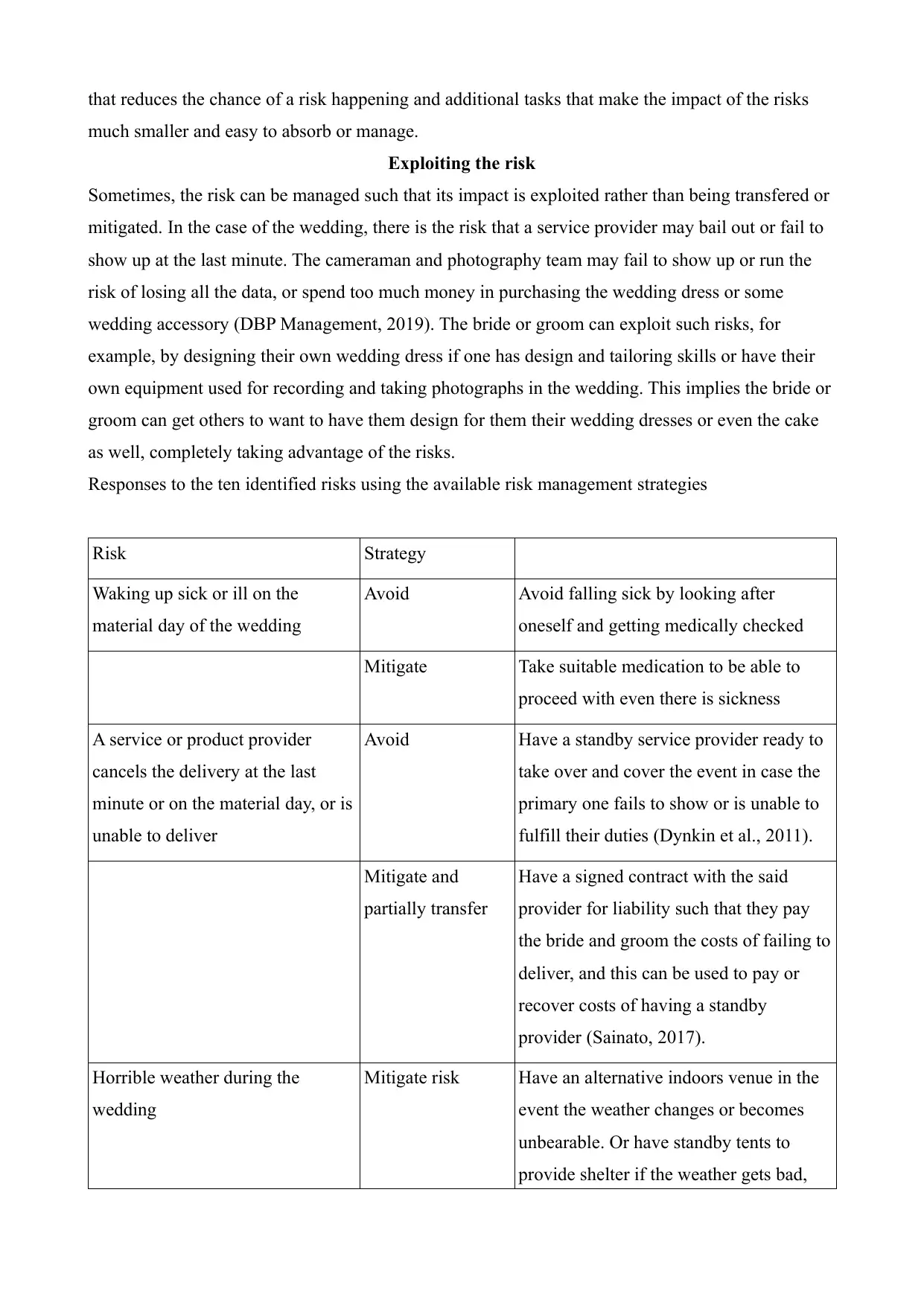
that reduces the chance of a risk happening and additional tasks that make the impact of the risks
much smaller and easy to absorb or manage.
Exploiting the risk
Sometimes, the risk can be managed such that its impact is exploited rather than being transfered or
mitigated. In the case of the wedding, there is the risk that a service provider may bail out or fail to
show up at the last minute. The cameraman and photography team may fail to show up or run the
risk of losing all the data, or spend too much money in purchasing the wedding dress or some
wedding accessory (DBP Management, 2019). The bride or groom can exploit such risks, for
example, by designing their own wedding dress if one has design and tailoring skills or have their
own equipment used for recording and taking photographs in the wedding. This implies the bride or
groom can get others to want to have them design for them their wedding dresses or even the cake
as well, completely taking advantage of the risks.
Responses to the ten identified risks using the available risk management strategies
Risk Strategy
Waking up sick or ill on the
material day of the wedding
Avoid Avoid falling sick by looking after
oneself and getting medically checked
Mitigate Take suitable medication to be able to
proceed with even there is sickness
A service or product provider
cancels the delivery at the last
minute or on the material day, or is
unable to deliver
Avoid Have a standby service provider ready to
take over and cover the event in case the
primary one fails to show or is unable to
fulfill their duties (Dynkin et al., 2011).
Mitigate and
partially transfer
Have a signed contract with the said
provider for liability such that they pay
the bride and groom the costs of failing to
deliver, and this can be used to pay or
recover costs of having a standby
provider (Sainato, 2017).
Horrible weather during the
wedding
Mitigate risk Have an alternative indoors venue in the
event the weather changes or becomes
unbearable. Or have standby tents to
provide shelter if the weather gets bad,
much smaller and easy to absorb or manage.
Exploiting the risk
Sometimes, the risk can be managed such that its impact is exploited rather than being transfered or
mitigated. In the case of the wedding, there is the risk that a service provider may bail out or fail to
show up at the last minute. The cameraman and photography team may fail to show up or run the
risk of losing all the data, or spend too much money in purchasing the wedding dress or some
wedding accessory (DBP Management, 2019). The bride or groom can exploit such risks, for
example, by designing their own wedding dress if one has design and tailoring skills or have their
own equipment used for recording and taking photographs in the wedding. This implies the bride or
groom can get others to want to have them design for them their wedding dresses or even the cake
as well, completely taking advantage of the risks.
Responses to the ten identified risks using the available risk management strategies
Risk Strategy
Waking up sick or ill on the
material day of the wedding
Avoid Avoid falling sick by looking after
oneself and getting medically checked
Mitigate Take suitable medication to be able to
proceed with even there is sickness
A service or product provider
cancels the delivery at the last
minute or on the material day, or is
unable to deliver
Avoid Have a standby service provider ready to
take over and cover the event in case the
primary one fails to show or is unable to
fulfill their duties (Dynkin et al., 2011).
Mitigate and
partially transfer
Have a signed contract with the said
provider for liability such that they pay
the bride and groom the costs of failing to
deliver, and this can be used to pay or
recover costs of having a standby
provider (Sainato, 2017).
Horrible weather during the
wedding
Mitigate risk Have an alternative indoors venue in the
event the weather changes or becomes
unbearable. Or have standby tents to
provide shelter if the weather gets bad,
⊘ This is a preview!⊘
Do you want full access?
Subscribe today to unlock all pages.

Trusted by 1+ million students worldwide
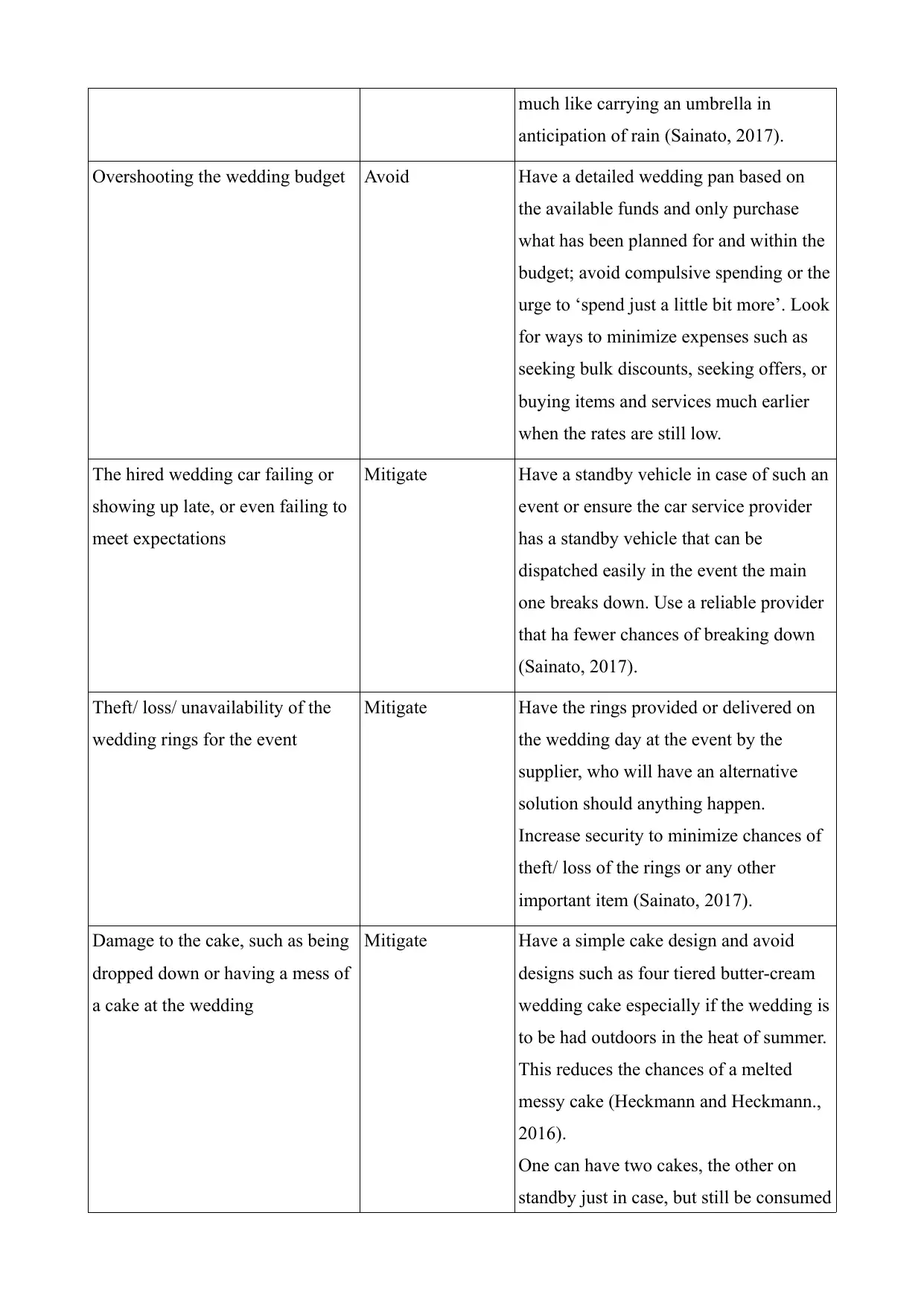
much like carrying an umbrella in
anticipation of rain (Sainato, 2017).
Overshooting the wedding budget Avoid Have a detailed wedding pan based on
the available funds and only purchase
what has been planned for and within the
budget; avoid compulsive spending or the
urge to ‘spend just a little bit more’. Look
for ways to minimize expenses such as
seeking bulk discounts, seeking offers, or
buying items and services much earlier
when the rates are still low.
The hired wedding car failing or
showing up late, or even failing to
meet expectations
Mitigate Have a standby vehicle in case of such an
event or ensure the car service provider
has a standby vehicle that can be
dispatched easily in the event the main
one breaks down. Use a reliable provider
that ha fewer chances of breaking down
(Sainato, 2017).
Theft/ loss/ unavailability of the
wedding rings for the event
Mitigate Have the rings provided or delivered on
the wedding day at the event by the
supplier, who will have an alternative
solution should anything happen.
Increase security to minimize chances of
theft/ loss of the rings or any other
important item (Sainato, 2017).
Damage to the cake, such as being
dropped down or having a mess of
a cake at the wedding
Mitigate Have a simple cake design and avoid
designs such as four tiered butter-cream
wedding cake especially if the wedding is
to be had outdoors in the heat of summer.
This reduces the chances of a melted
messy cake (Heckmann and Heckmann.,
2016).
One can have two cakes, the other on
standby just in case, but still be consumed
anticipation of rain (Sainato, 2017).
Overshooting the wedding budget Avoid Have a detailed wedding pan based on
the available funds and only purchase
what has been planned for and within the
budget; avoid compulsive spending or the
urge to ‘spend just a little bit more’. Look
for ways to minimize expenses such as
seeking bulk discounts, seeking offers, or
buying items and services much earlier
when the rates are still low.
The hired wedding car failing or
showing up late, or even failing to
meet expectations
Mitigate Have a standby vehicle in case of such an
event or ensure the car service provider
has a standby vehicle that can be
dispatched easily in the event the main
one breaks down. Use a reliable provider
that ha fewer chances of breaking down
(Sainato, 2017).
Theft/ loss/ unavailability of the
wedding rings for the event
Mitigate Have the rings provided or delivered on
the wedding day at the event by the
supplier, who will have an alternative
solution should anything happen.
Increase security to minimize chances of
theft/ loss of the rings or any other
important item (Sainato, 2017).
Damage to the cake, such as being
dropped down or having a mess of
a cake at the wedding
Mitigate Have a simple cake design and avoid
designs such as four tiered butter-cream
wedding cake especially if the wedding is
to be had outdoors in the heat of summer.
This reduces the chances of a melted
messy cake (Heckmann and Heckmann.,
2016).
One can have two cakes, the other on
standby just in case, but still be consumed
Paraphrase This Document
Need a fresh take? Get an instant paraphrase of this document with our AI Paraphraser
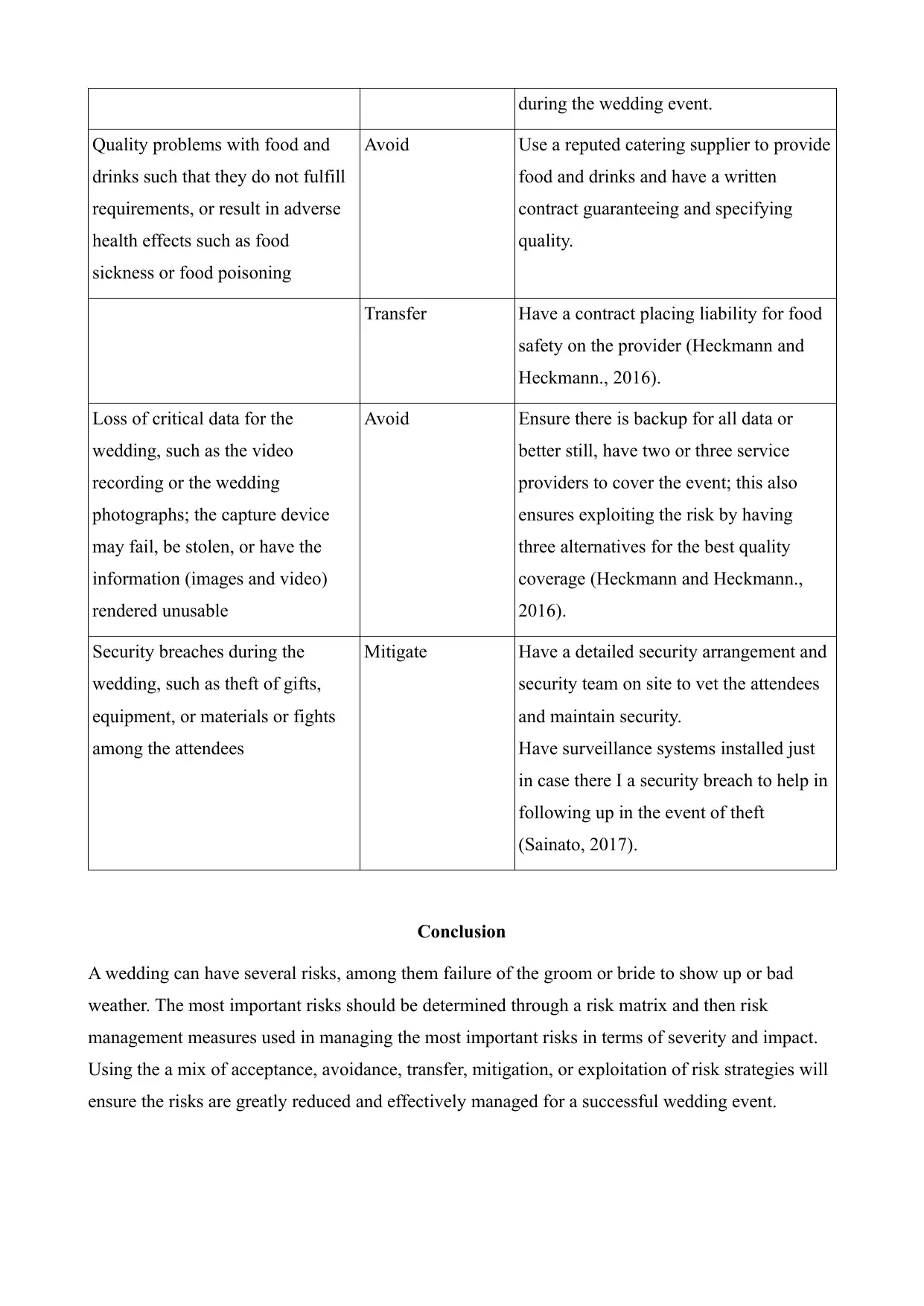
during the wedding event.
Quality problems with food and
drinks such that they do not fulfill
requirements, or result in adverse
health effects such as food
sickness or food poisoning
Avoid Use a reputed catering supplier to provide
food and drinks and have a written
contract guaranteeing and specifying
quality.
Transfer Have a contract placing liability for food
safety on the provider (Heckmann and
Heckmann., 2016).
Loss of critical data for the
wedding, such as the video
recording or the wedding
photographs; the capture device
may fail, be stolen, or have the
information (images and video)
rendered unusable
Avoid Ensure there is backup for all data or
better still, have two or three service
providers to cover the event; this also
ensures exploiting the risk by having
three alternatives for the best quality
coverage (Heckmann and Heckmann.,
2016).
Security breaches during the
wedding, such as theft of gifts,
equipment, or materials or fights
among the attendees
Mitigate Have a detailed security arrangement and
security team on site to vet the attendees
and maintain security.
Have surveillance systems installed just
in case there I a security breach to help in
following up in the event of theft
(Sainato, 2017).
Conclusion
A wedding can have several risks, among them failure of the groom or bride to show up or bad
weather. The most important risks should be determined through a risk matrix and then risk
management measures used in managing the most important risks in terms of severity and impact.
Using the a mix of acceptance, avoidance, transfer, mitigation, or exploitation of risk strategies will
ensure the risks are greatly reduced and effectively managed for a successful wedding event.
Quality problems with food and
drinks such that they do not fulfill
requirements, or result in adverse
health effects such as food
sickness or food poisoning
Avoid Use a reputed catering supplier to provide
food and drinks and have a written
contract guaranteeing and specifying
quality.
Transfer Have a contract placing liability for food
safety on the provider (Heckmann and
Heckmann., 2016).
Loss of critical data for the
wedding, such as the video
recording or the wedding
photographs; the capture device
may fail, be stolen, or have the
information (images and video)
rendered unusable
Avoid Ensure there is backup for all data or
better still, have two or three service
providers to cover the event; this also
ensures exploiting the risk by having
three alternatives for the best quality
coverage (Heckmann and Heckmann.,
2016).
Security breaches during the
wedding, such as theft of gifts,
equipment, or materials or fights
among the attendees
Mitigate Have a detailed security arrangement and
security team on site to vet the attendees
and maintain security.
Have surveillance systems installed just
in case there I a security breach to help in
following up in the event of theft
(Sainato, 2017).
Conclusion
A wedding can have several risks, among them failure of the groom or bride to show up or bad
weather. The most important risks should be determined through a risk matrix and then risk
management measures used in managing the most important risks in terms of severity and impact.
Using the a mix of acceptance, avoidance, transfer, mitigation, or exploitation of risk strategies will
ensure the risks are greatly reduced and effectively managed for a successful wedding event.

⊘ This is a preview!⊘
Do you want full access?
Subscribe today to unlock all pages.

Trusted by 1+ million students worldwide
1 out of 15
Related Documents
Your All-in-One AI-Powered Toolkit for Academic Success.
+13062052269
info@desklib.com
Available 24*7 on WhatsApp / Email
![[object Object]](/_next/static/media/star-bottom.7253800d.svg)
Unlock your academic potential
Copyright © 2020–2025 A2Z Services. All Rights Reserved. Developed and managed by ZUCOL.




